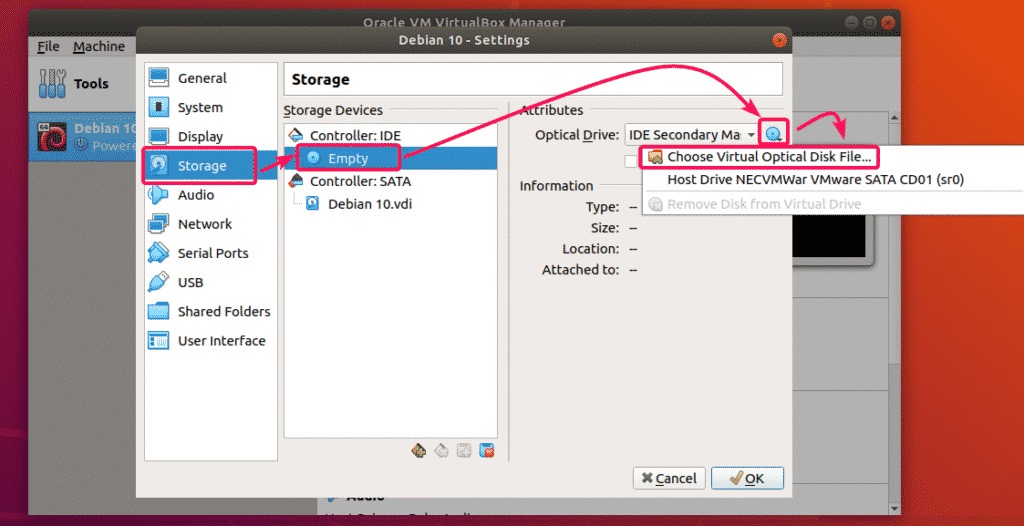
- #WHAT IS A VIRTUAL OPTICAL DISK FILE INSTALL#
- #WHAT IS A VIRTUAL OPTICAL DISK FILE UPDATE#
- #WHAT IS A VIRTUAL OPTICAL DISK FILE WINDOWS 10#
- #WHAT IS A VIRTUAL OPTICAL DISK FILE ISO#
BenQ, LiteOn, LG, NEC, Optiarc, Pioneer, Plextor, Samsung, Sony).

It supports all the latest drives without the need for updates (including booktype / bitsetting / advanced settings on many of the major ones - i.e. It's a very flexible application with several advanced features that are often lacking in other tools, especially when it comes to burning DVD Video discs. If you use Wine, it should also run on Linux and other x86-based Unixes.

#WHAT IS A VIRTUAL OPTICAL DISK FILE WINDOWS 10#
ImgBurn supports all the Microsoft Windows OS's - Windows 95, Windows 98, Windows Me, Windows NT4, Windows 2000, Windows XP, Windows 2003, Windows Vista, Windows 2008, Windows 7, Windows 8 and Windows 10 (including all the 64-bit versions). It supports Unicode folder/file names, so you shouldn't run in to any problems if you're using an international character set. You can use it to build DVD Video discs (from a VIDEO_TS folder), HD DVD Video discs (from a HVDVD_TS folder) and Blu-ray Video discs (from a BDAV / BDMV folder) with ease. It can burn Audio CD's from any file type supported via DirectShow / ACM - including AAC, APE, FLAC, M4A, MP3, MP4, MPC, OGG, PCM, WAV, WMA and WV. If you want to manually re-install it, you can see our VirtualBox Guest Guide.ImgBurn supports a wide range of image file formats - including BIN, CCD, CDI, CUE, DI, DVD, GI, IMG, ISO, MDS, NRG and PDI.
#WHAT IS A VIRTUAL OPTICAL DISK FILE INSTALL#
If it is, should then automatically install any additional tools (such as virtualbox-guest-x11) to give a better user experience.
#WHAT IS A VIRTUAL OPTICAL DISK FILE ISO#
We will now press “Add”, then navigate to where our ISO is located.Īfter pressing “Open”, we can see its been added, so we make sure its selected and press “Choose”.Īll that is left now to do is press “Start”.Īfter all this is done, we save, start up the VM, and then continue installing Kali Linux as we normally would for a bare metal install.ĭuring Kali Linux setup process, the install wizard should detect if its inside a VM. We want to use our Kali image, rather than a physical drive, so we select the icon to the side of the drop down.Ī new pop up will open, “Optical Disk Selector”. The first time we run it, we will get a prompt saying do we wish to mount an image to use as a “start-up disk”. The final settings view looks like the following: In “Display” -> “Screen”, we make sure to have “Video Memory” set to 128 MBĪnother item to point out is to make sure that “Accelerated 3D graphics” is disabled, as people have reported that causes issues. In “System” -> “Processor”, we increase the “Processor(s)” to be 2.Īt the same time, we also enable “Extended Features” for Enable PAE/NX. In “System” -> “Motherboard”, we change the “Boot Order” to make sure Hard Disk is top and Optical is the second. In “General” -> “Advanced”, we make sure to set “Shared Clipboard” to bidirectional, as well as “Drag’n’Drop” to bidirectional Now we click on “Settings”, to customize the VM further. We use 80.00 GB for our VMs.Īfter clicking on “Create”, the wizard is complete. Now with “File location and size”, we can now define how large the virtual hard disk will be. This screen below, “Hard disk”, allows us to Create a new virtual disk now.įor the “Hard disk file type”, we select VDI (VirtualBox Disk Image) (and its the default option).įor the following screen, “Storage on physical hard disk”, we go with the default option of Dynamically allocated. When we make the general VMs, we select 2048 MB (2GB) for RAM, but we often increase this for our personal machines as we have high-performing devices with spare RAM which Kali can utilize. Various tools inside of Kali can be demanding of resources. Again, the higher the amount of RAM, the more applications can be open and at increased performance. “Memory size” is the next section, where we can define how much RAM to use.

For the “Version”, we are going to be using the 圆4 desktop image, so we are going to select Debian (64-bit).

Example: kali-linux-2022.1-vbox-amd64).įor the “Type”, we set it as Linux.
#WHAT IS A VIRTUAL OPTICAL DISK FILE UPDATE#
We are keeping it generic in this guide (as Kali is a rolling distribution, and we update it), however for our releases, we use the version number in the name as it is a fixed release ( kali-linux-YYYY.N-vbox-ARCH. This name is also used in any filenames (such as the configuration, hard disk and snapshot - which isn’t changed from this point). The next screen is “Name and operating system” which is where you name the VM. Upon starting up VirtualBox, select “New” (Machine -> New). You may need to enable virtualization in your BIOS/UEFI for (e.g.


 0 kommentar(er)
0 kommentar(er)
